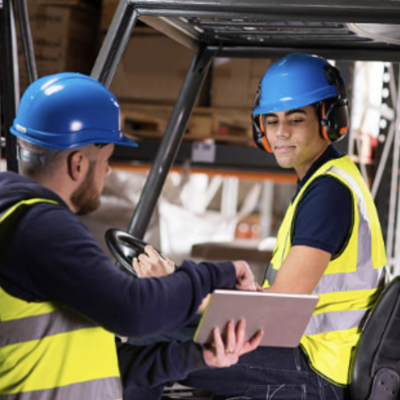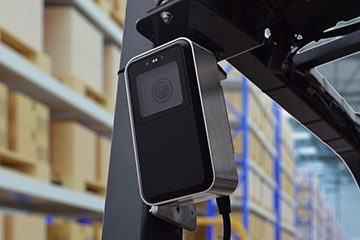
““In our visits with facility and safety managers, they report that the constant training of new hires and getting them up to speed on safety protocols is one of their biggest challenges.”

New or Fatigued Workers Can Raise Accident Rates
Three OmniPro Visual A.I. Technology Solutions for Lowering Risk
An unprecedented number of people left their jobs in “The Great Resignation.” That economic trend, which began in 2021, saw as many as one in five workers quitting jobs, creating a tighter labor market and elevated workforce turnover. While this trend has moderated, the U.S. Bureau of Labor Statistics says that industrial employee turnover rates remain high.1 Considering the resources required to interview, hire and train new workers, the onboarding process can be costly and time-consuming for companies. But the challenge may be even bigger than that. New workers, studies say, are much more likely to be injured than experienced ones.
A 2022 “Injury Impact Report” by Travelers, a leading workers compensation carrier which analyzed more than 1.5 million workers compensation claims, found that 35% of workplace injuries occurred during a worker’s first year on the job.2 The US Bureau of Labor Statistics supports these numbers, reporting that more than one-third of work-related, nonfatal injuries occur in employees who have been on the job less than a year.3
“In our visits with facility and safety managers, they report that the constant training of new hires and getting them up to speed on safety protocols is one of their biggest challenges,” said Brian Jones, Matrix Vice President of Business Development.
With a workforce in constant flux, employees are often asked to put in longer hours, yet research indicates that working 12 hours per day is associated with a 37% increased risk of injury.4 So what can companies do to reduce the likelihood of accidents? Matrix Design Group, a top U.S. safety technology company, has implemented numerous technology innovations in its OmniPro Vision AI collision avoidance system that support a safer workplace, with a particular focus on mitigating risk for new and fatigued employees.
Three Solutions for Lowering Risk in Industrial Settings
Visual A.I. “sees” when and where workers can’t
OmniPro’s object detection and recognition technology can be taught to “see” and alert on key elements in its environment. In the industrial setting, for example, the OmniPro collision avoidance system identifies people and objects, such as forklifts, stop signs and pedestrian signs. Alert zones can be customized to the workplace. Especially when a worker is inexperienced or tired, this camera system provides a safety backstop that can help prevent accidents.
Solutions for near-miss problems
The Health and Safety Executive (the UK’s version of OSHA) says that for every accident, there are roughly 90 near misses.5 With higher accident rates among new and fatigued employees, reporting on near-miss incidents can provide important safety data. OmniPro records all zone breaches with timestamped photos, providing a cloud-accessible log that can be used in near-miss reporting initiatives to identify problem areas and employees that may need additional training. Many organizations have found such initiatives to be highly beneficial in reducing accidents.
Alerting the distracted or fatigued worker
New workers have to manage large amounts of unfamiliar information and stimuli; employees completing long or extended shifts can have their senses dulled. OmniPro Vision AI has been designed with custom warning (yellow) and alert (red) zones so that only when a potential danger occurs does the red light flash and the system issue an alert. Because Matrix has fine-tuned the system extensively, nuisance alerts are minimized, lowering the possibility that workers will become desensitized to them. Optional machine integration that slows the machine or deactivates the pedal is available, as well.
“Our OmniPro Vision AI collision avoidance system bridges the knowledge gap, helping new operators avoid accidents as they gain experience,” said Jones. “While it provides critical support for any worker, the OmniPro camera system offers increased safeguards for those who are new to the job or experiencing fatigue during their shift.”
OmniPro’s use of visual artificial intelligence also eliminates the need for personal location devices or tags, removing the added expense and safety issues that come with lost or broken devices.
With the high cost of accidents, both to employee morale and company finances, safety is key to a successful workplace. When employees know that management actively looks out for their welfare, they are more likely to stay.
Ask us for a free quote! You can learn more at www.matrixteam.com/omnipro-vision-ai/ or contact us at sales@matrixteam.com.
Blog – Real-Time Data and A.I.: How Collision Avoidance Taps New Tech to Boost Facility Safety
___________________________________________________________
1 – S. Bureau of Labor Statistics: Annual total separations rates by industry and region, not seasonally adjusted
https://www.bls.gov/news.release/jolts.t16.htm
2 – Travelers Injury Impact Report
https://www.travelers.com/resources/business-topics/workplace-safety/injury-impact-report
3 – U.S. Bureau of Labor Statistics: Number of nonfatal occupational injuries and illnesses involving days away from work by selected worker characteristics and number of days away from work, and median number of days away from work, private industry, 2020
https://www.bls.gov/web/osh/cd_r71.htm
4 – Dembe A, Ericson JB, Delbos RG, Banks SM [2005]. The impact of overtime and long work hours on occupational injuries and illnesses: New evidence from the United States. Occup Environ Med 62:588_597.
https://www.osha.gov/worker-fatigue/hazards
5 – Near-Miss Book, Health and Safety Executive, Government of the UK
